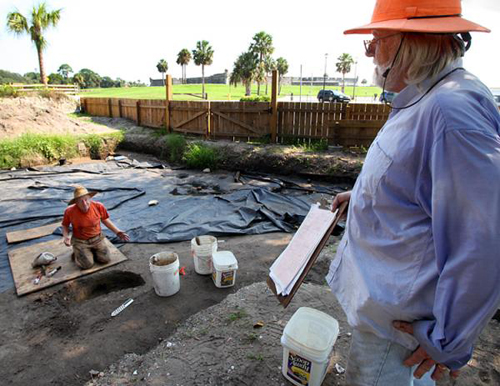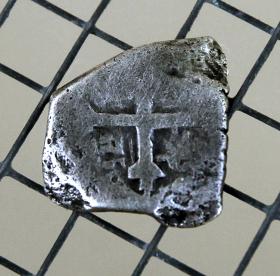
St. Augustine’s City Archaeologist Carl Halbirt, on right, oversees a local volunteer during excavations of a newly discovered site believed to be one of the settlement’s early wooden forts.
St. Augustine’s City Archaeologist, Carl Halbirt is a great friend and colleague, and one of the most productive and knowledgeable archaeologists I’ve had the pleasure of working with. Congratulations to him on one of his greatest discoveries: the apparent remains of one of St. Augustine’s early wooden forts, dating perhaps to the late 1500s. This story made a big splash when it hit the front page of the St. Augustine Record the other day, and rightly so. If this site does indeed prove to be what we think it is, it will be one of the most significant finds ever made in this most archaeologically significant of American cities.
St. Augustine City Archaeologist Carl Halbirt and his team believe they are on the verge of a major discovery connected to the city’s colonial Spanish history.
Since January, Halbirt has been digging on a parcel in the back of the Spanish Quarter hoping that the site may be where once stood one of the nine Spanish wooden forts that preceded the Castillo de San Marcos, the 17th-century coquina fort that sits in majestic silence across the road.
“Although it’s mostly conjecture at this point, this could be one of the most significant archaeological finds we’ve made in St. Augustine,” Halbirt said. “To date, we’ve never found any physical evidence of any of the wooden forts that we know the Spanish built here before the Castillo.”
Halbirt’s team has uncovered 12 post holes, and two remnants of wooden posts, along with several artifacts dating from the late 1500s or early 1600s.
The post holes are in two direct parallel alignments, and Halbirt believes they may be the footprint of a wooden fort, possibly 100 feet in length.
“We’ve been able to determine that the holes were 3 feet in diameter, and the posts were about 7 or 8 inches in diameter,” Halbirt said. “This indicates a very large wooden structure.”
Halbirt said that whenever somebody digs a hole and then fills it back in, the evidence of the hole can remain hundreds, or even thousands of years later. Other artifacts found at the site have indicated that the fort may be from the late 1500s, which could make it the eighth wooden fort of nine built before the coquina fort.

This Spanish coin, a silver half-real, dates to between 1590 and 1598, providing an early date for the recently discovered fortifications.
“The level of importance of this find can’t be overstressed,” Powell [of the Colonial Spanish Quarter Living History Museum] said. “Initially, we thought it might be the ninth fort, but the artifacts seem to point to an earlier period.”
Despite the significance of the find, archaeological excavations came to an abrupt halt when the National Park Service realized that digs taking place decades earlier had unearthed skeletal remains near the present location (which is on National Park Service property). According to a second story in the Record, the National Park Service, after consulting a number of Native American tribes with historic affiliations to the area, has shut down all excavations, at least for the time being. Further work will need to incorporate the partnership with any such tribes whose ancestors’ remains might be impacted by excavation.
So further discoveries await, for now. Archaeology is not for the impatient! Congratulations to Carl for such a great and significant find!
Photographs by Daron Dean, courtesy of the St. Augustine Record

